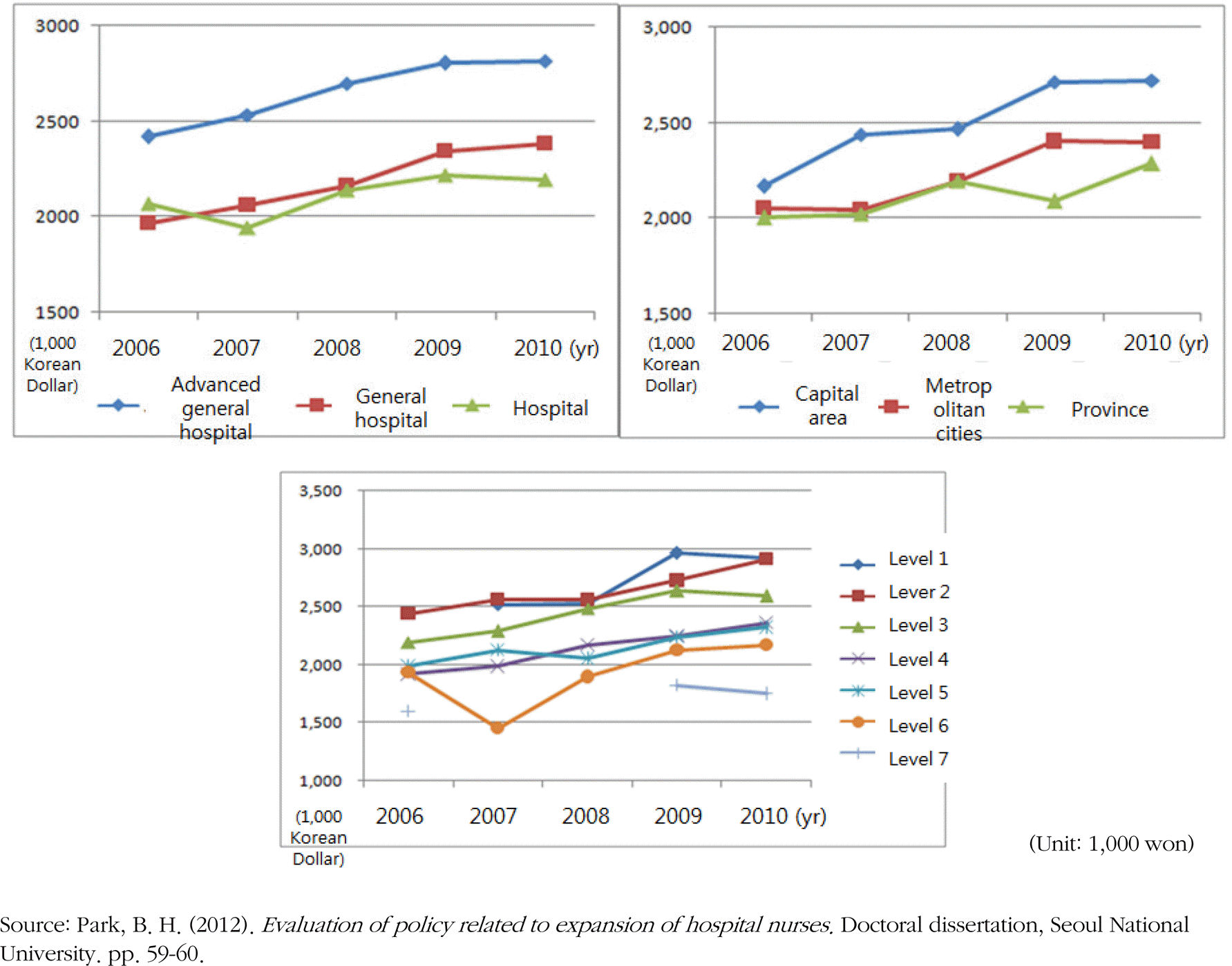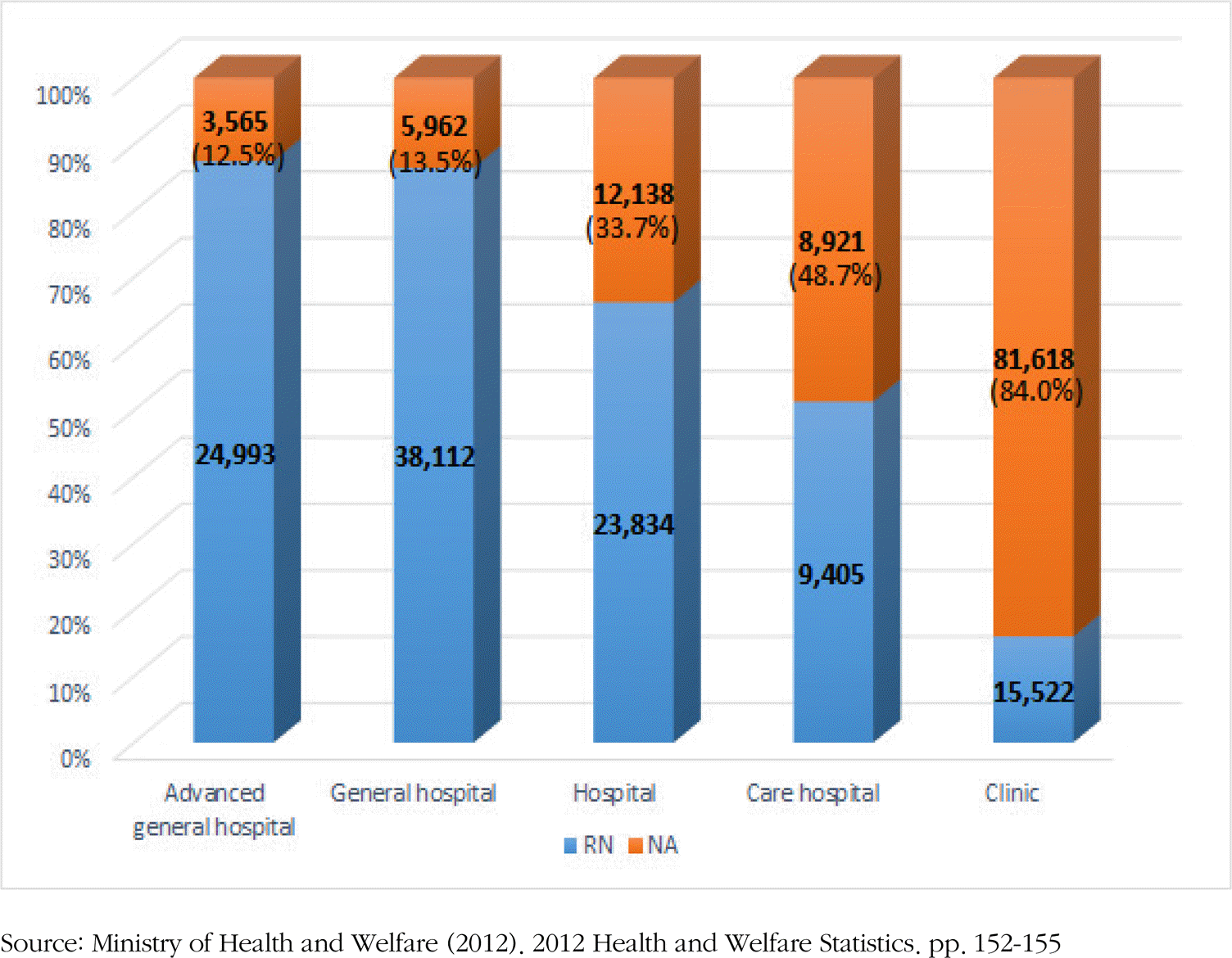Abstract
Purpose
The plan proposed by the Ministry of Health and Welfare in 2012 did not reflect the position of nurses and focused only on how to increase the number of nurses. There is a need for coming up with a specific and viable alternative plan considering the qualitative aspect of nursing, delegation of nursing tasks, the in-death analysis of the reasons for leaving the nursing profession, and the legal standards based on varying nursing tasks.
Methods
Drawing on a review of existing literature, this report was written to examine policy directions and the factors that influence the institutional environment that regulates the supply and demand of the nursing workforce in Korea.
Results
Implementing the government's plan for introducing a new type of nurse, the registered practical nurse, which generally requires a two-year associate's degree, must be reconsidered. Also, a concrete plan to make use of unemployed nurses and to close the salary gap between nurses working at hospitals in cities and those working at hospitals in rural areas must be prepared. Furthermore, there is a need for introducing a new rating system aimed at boosting the quality of nursing care in small-and medium-sized hospitals, thereby increasing the number of nursing professionals who provide high quality care.
Conclusion
In preparation for expected poor quality of care and looming unemployment crisis due to the increase in the number of nursing professionals, a practical and concrete plan for the supply and demand of the nursing workforce should be made. The Korean Nurses Association should mount a profession-wide campaign to make the government formulate a new and viable policy on the supply and demand of the nursing workforce.
Go to : 
REFERENCES
Buchan J.., Black S.2011. The impact of pay increases on nurses' labour market: A review of evidence from four OECD countries. OECD Health Working Paper. Paris: OECD.
Cho Y. K.2013. A structural equation model on new graduate nurses' turnover intentions and turnover. (Doctoral Dissertation), Ewha Womans University, Seoul. Retrieved from. http://www.riss.kr/link?id=T13252735.
Fochsen G.., Sjögren K.., Josephson M.., Lagerström M.2005. Factors contributing to the decision to leave nursing care: a study among Swedish nursing personnel. Journal of Nursing Management. 13(4):338–344.

Han J. R.2011, December 20. ). A Refutation on. "no more nurse shortage due to four year course unification of nursing education". , Korean Nurses Association, Daily Medipharm. Retrieved from. http://dailymedipharm.com/news_view.jsp?pg=0&ncd=1895.
Han S. S.., Sohn I. S.., Kim N. E.2009. New nurse turnover intention and influencing factors. Journal of Korean Academy of Nursing. 39(6):878–887. http://dx.doi.org/10.4040/jkan.2009.39.6.878.

Health Insurance Review and Assessment Service. 2011. Current situation of hospital rooms of medical care facilities by types of care services (before the first quarter of 2011). , Korean Statistical Information Service. Retrieved September 2, from. http://kosis.kr/nsikor/view/stat10.do.
Health Insurance Review and Assessment Service. 2013. Current situation of hospital rooms of medical care facilities by types of care services (after the second quarter of 2011). Korean Statistical Information Service. Retrieved October, 2, from. http://kosis.kr/nsikor/view/stat10.do.
Jones R. S.2010. Healthcare reform in Korea. OECD economics department working papers, No. 797. OECD Publishing.

Kim G. L.., Lee H. J.., Cho Y. S.., Kim M. H.2013. The experience of turnover decision making in new graduate nurses. Journal of Qualitative Research. 14(1):23–33.
Kim H. R.., Yeo J. Y.., Kang S. W.., Jung Y. H.., Lee S. H.2012. Review of the Korean health care system performance during 2000-2010 and policy implications based on OECD health data. Seoul: Korea Institute for Health and Social Affairs.
Kim J. H.2013. Current situation and policy direction of the nursing workforce supply. Paper presented at the Pannel Discussion for the Direction for Reorganization of Nursing Staff System in Korea. Seoul National University, Seoul.
Kim M. J.., Han S. S.2007. Comparison of job satisfaction, commitment to organization, nursing organization culture and job experience between national/public hospital nurses and private hospital nurses. Journal of East-West Nursing Research. 13(1):22–30.
Kim S. M.2010. A study on job expansion in health care sector and suggestions on the improvement of work quality. Seoul: Economic and Social Development Commission of Korea.
Kim S. M.., Roh Y. J.., Kim J. I.., Park J. S.2010. A study on creating healthcare jobs and improving the quality of work. p. 70. Seoul: Family Harmony Strategic Institute.
Kim Y. S.2010. ). Analyze Korean hospitals. 2010! A Paper presented at the International Seminar on the Hospital Workforce. Seoul.
Kim Y. S.., Kwon M. K.2010. Nurses' parenting stress. Korean Parent-Child Health Journal. 13(2):86–94.
Korean Hospital Nurses Association. 2012. Survey on the current nurse deployment, A report of hospital nurses association. 2012 (pp.p. 99–109. Seoul: Hospital Nurses Association.
Lavoie-Tremblay M.., O'brien-Pallas L.., Gelinas C.., Desforges N.., Marchionni C.2008. Addressing the turnover issue among new nurses from a generational viewpoint. Journal of Nursing Management. 16(6):724–733.

Lee Y. J.2010. Supply and demand of clinical nurses and policy alternative. Paper presented at the International Seminar for the Secure of Hospital Resources and the Improvement of Shift Working, Seoul.http://blog.daum.net/bogun1004/262.
Ministry of Health and Welfare, and Korea Institute for Health and Social Affairs. 2012. OECD Health Data 2012. Seoul: Ministry of Health and Welfare;Retrieved from. http://www.bokjiro.go.kr/data/statusView.do?board_sid=297&data_sid=5836842.
Ministry of Health and Welfare, Division of Healthcare Policy. 2013. Direction for Reorganization of Nursing Staff System in Korea. Seoul: Ministry of Health and Welfare;, Retrieved from. http://www.mw.go.kr/front_new/al/sal0301vw.jsp?PAR_MENU_ID=04&MENU_ID=0403&CONT_SEQ=281554&page=1.
Ministry of Health and Welfare. 2012. 2012 Health and Welfare Statistics. (11-1352000-000137-10). Seoul: Ministry of Health and Welfare;Retrieved from. http://stat.mw.go.kr/front/statData/mohwAnnalsWpView.jsp?menuId=14&bbsSeq=1&nttSeq=20398&nttClsCd=01&searchKey=&searchWord=&nPage=1.
National Health Personnel Licensing Examination Board. 2013. Licensing examination statistics of nurses. Retrieved September 21, 2013, from. http://www.kuksiwon.or.kr/Information/ExamStatistic.aspx.
Oh Y. H.2008. Prospect of supply and demand of nursing resources. Paper presented at the Korean Society of Health Policy and Administration Scientific Conference in 2008, Interburgo Hotel, Daegu.
Oh Y. H.2012. Supply of the healthcare institutions and the hospital beds. Issue & Focus. 129:1–8.
Organization for Economic Cooperation Development. 2011. Health at a glance 2011: OECD Indicators. OECD.
Park B. H.2012. Evaluation of policy related to expansion of hospital nurses. Doctoral Dissertation, Seoul National University, School of Public Health, Seoul. Retrieved from. http://www.riss.kr/link?id=T12810448.
Park K. O.2010. Korean Nursing Association's Suggestions for Solving Nurse Shortage. A source book of policy debate (pp.p. 25–33. Seoul: Korean Hospital Association.
Shin J. S.2011, December 20. ). No manpower shortage caused by the unification of nursing education. Daily Medipharm. Retrieved from. http://www.monews.co.kr/Item/45724/.
Shin K. R.2008, June 13. To activate inactive registered nurse license. Chosun Ilbo.
Wangensteen S.., Johansson I. S.., Nordström G.2008. The first year as a graduate nurse-An experience of growth and development. Journal of Clinical Nursing. 17(14):1877–1885.
Yoon S. H.2002. A study on new graduate nurses' clinical experience of adaptation. Journal of Korean Nursing Administration Academic Society. 8(1):55–72.
Go to : 
 | Figure 2.The salary of new nurses by different types of medical facilities, by regions and by nursing rating. |
Table 1.
Proposed Changes to the Nursing Workforce Structure
Table 2.
Changes in the Composition of the Nursing Workforce by Different Types of Medical Facilities from 2003 to 2011
Table 3.
Rate of Increase in Hospital Beds by Different Types of Medical Facilities from 2000 to 2010
Table 4.
Change of Number of Registered Nurses and Employment Rate
Table 5.
Nurses' Turnover Rate by the Type and Number of Hospital Beds
Table 6.
Point of Turnover of New Nurses




 PDF
PDF ePub
ePub Citation
Citation Print
Print



 XML Download
XML Download